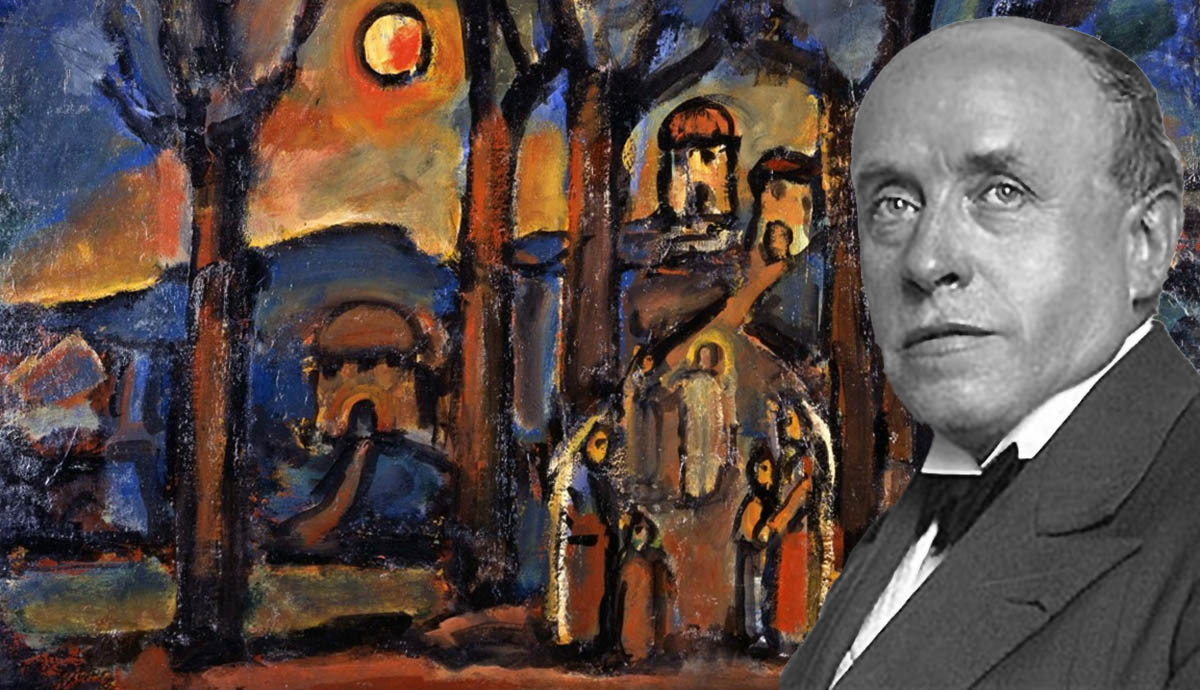
Known most often as a French painter and graphic artist, Georges Rouault interestingly brought deeply religious themes to the modern art movement in the late 19th and early 20th centuries.
His work has been seen all over the world and with a modest idea of what the world should be, he expressed himself through art.
Read on to learn more about Rouault and his intriguing contributions to the modern age.
Rouault was trained in stained glass and was a master of the art form.

Rouault was born into a family with artistic inclinations. Between 1885 and 1890 he worked as a stained-glass apprentice and restored medieval windows. In the evenings, he attended the Ecole des Arts Decoratifs and later studied at the Ecole des Beaux-Arts.
His experience with stained glass influenced much of his painting as he often outlined his subjects in black which gave the work a stained glass feel. You can see his signature style in pieces like Passion Suite: Christ aux Portes de la Ville, La Parade, and Paysage aux Grands Arbres (Bord de Mer).


Sometime between 1895 and 1898 Rouault became a devout Roman Catholic after an emotional breakdown.
Stained glass is often associated with religious spaces, especially Catholic cathedrals. Rouault loved working with stained glass and some can say it was his first love as an artist. Perhaps it was this connection that drew him to Roman Catholicism after going through a tough time in his life.
His work from then on was much more moralistic and religious than in his earlier paintings, much of which was a commentary on the “flaws” he saw in Parisian life. The remainder of his career would produce disdainful paintings of prostitutes and clowns while continuously returning to the subject of Christ himself.
Rouault was passionately critical of hypocrisy, sin, and war with strong convictions about how to lead a “good” life. His disdain for some of the subjects he painted is evident not only in the subjects he chose but also in his brushstrokes and color palette.
His piece Prostitute before Her Mirror depicts a woman in a loathing and revolting way, similar to the repulsive way he painted Clown Traguique, who’s name speaks for itself.


In his depictions of Christ and other religious figures, you can see that he was a bit kinder with the paintbrush and expresses something much more tender while maintaining his artistic integrity.


Although considered to be part of both Fauvism and Expressionism, Rouault doesn’t quite fit into either of these camps.
During his time studying at the Ecole des Beaux-Arts, Rouault became the favorite student of Gustave Moreau and his fellow students at the school included Henri Matisse and Albert Marquet. He participated in the original Salon d’Automne with Matisse and Marquet and exhibited with the Fauves in 1905, but he didn’t truly belong to this group or any others.
He was painting in the communities that were experimenting with Fauvism and Expressionism, but since he didn’t stick to portraits, landscapes, watercolor, or oil paintings, it’s difficult to classify him as any one kind of artist.
Still, with his wild brushstrokes and use of non-natural colors, you can see why people would consider him a Fauvist. Plus, with his deeply personal expressions through his paintings of how he saw the world, it’s easy to see him as a part of Expressionism, too.
In addition to painting, Rouault also wrote prose and poetry.
Aside from painting, Rouault was also skilled in various genres. His dealer Ambroise Vollard commissioned him for book illustrations due to his skilled graphic work while also experimenting with etching, wood engraving, tapestries, enamels, and color lithography.
He published several autobiographical books such as Souvenirs intimes and Stella Vespertina and he continued to work with stained glass until late in life.
Along with many other prolific artists of the earlier 20th century, Rouault was also asked to design a ballet. The Prodigal Son for the Ballet Russes by dancer and choreographer Sergei Diaghilev was designed by Rouault.

In 1948, Rouault published his series called Miserere that has been deemed one of the greatest achievements in modern printmaking and although he continued to paint clowns and religious figures until his death, they became less and less satirical.

Rouault died in Paris on February 13, 1958, at the age of 86 and was given a state funeral. Today, you can see his work in collections at the Carnegie Museum of Art, the Tate Gallery in London, the Musee d’Orsay in Paris, and elsewhere.







